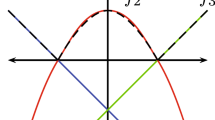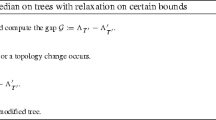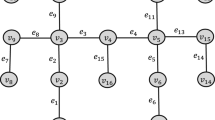Abstract
In the classicalp-center location model on a network there is a set of customers, and the primary objective is to selectp service centers that will minimize the maximum distance of a customer to a closest center. Suppose that thep centers receive their supplies from an existing central depot on the network, e.g. a warehouse. Thus, a secondary objective is to locate the centers that optimize the primary objective “as close as possible” to the central depot. We consider tree networks and twop-center models. We show that the set of optimal solutions to the primary objective has a semilattice structure with respect to some natural ordering. Using this property we prove that there is ap-center solution to the primary objective that simultaneously minimizes every secondary objective function which is monotone nondecreasing in the distances of thep centers from the existing central depot.
Restricting the location models to a rooted path network (real line) we prove that the above results hold for the respective classicalp-median problems as well.
Similar content being viewed by others
References
R.E. Barlow, D.J. Bartholomew, J.M. Bremner and H.D. Brunk,Statistical Inference Under Order Restrictions (Wiley, New York, 1972).
M.J. Best and N. Chakravarti, “Active set algorithms for isotonic regression; a unifying framework,”Mathematical Programming 47 (1990) 425–440.
G. Birkhoff.Lattice Theory (American Mathematical Society, Providence, RI, 1967).
T.Y. Cheung, “Multifacility location problem with rectilinear distance by the minimum cut approach,”ACM Transactions of Math Software 6 (1980) 549–561.
N.Chakravarti, “Isotonic median regression: A linear programming approach,”Mathematics of Operations Research 14 (1989) 303–308.
P.M. Dearing, R.L. Francis and T.J. Lowe, “Convex location problems on tree networks,”Operations Research 24 (1976) 628–642.
R.L. Francis, T.J. Lowe and H.D. Ratliff, “Distance constraints for tree network multifacility location problems,”Operations Research 26 (1978) 570–596.
G.N. Frederickson, “Optimal algorithms for partitioning trees and locatingp-centers in trees,” Technical Report, Department of Computer Science, Purdue University (West Lafayette, IN, 1990).
G. Grätzer,Lattice Theory (Freeman, San Francisco, CA, 1971).
D. Gusfield and E. Tardos, “A faster parametric minimum cut algorithm,” Technical Report No. 926, School of Operations Research and Industrial Engineering, Cornell University (Ithaca, NY, 1990).
R. Hassin and A. Tamir, “Improved complexity bounds for location problems on the real line,”Operations Research Letters 10 (1991) 395–402.
O. Kariv and S.L. Hakimi, “An algorithmic approach to network location problems. Part 1: Thep-centers,”SIAM Journal on Applied Mathematics 37 (1979) 513–538.
Y. Kaufman and A. Tamir, “Locating service centers with precedence constraints,” to appear in:Discrete Applied Mathematics.
A.J.W. Kolen, Tree Network and Planar Rectilinear Location Theory,CWI Tract No. 25 (Centre for Mathematics and Computer Science, Amsterdam, 1986).
A. Kolen and A. Tamir, “Covering problems,” in: P.B. Mirchandani and R.L. Francis, eds.,Discrete Location Theory (Wiley, New York, 1990) pp. 263–304.
J. Picard and H. Ratliff, “A cut approach to the rectilinear distance facility location problem,”Operations Research 26 (1978) 422–433.
A. Tamir, “A unifying location model on tree graphs based on submodularity properties,” to appear in:Discrete Applied Mathematics.
V.A. Trubin, “Effective algorithm for the Weber problem with rectangular metric,”Cybernetics 14 (1978) 874–878.
A.F. Veinott, Jr., “Representation of general and polyhedral subsemilattices and sublattices of product spaces,”Linear Algebra and its Applications 114/115 (1989) 681–704.
Author information
Authors and Affiliations
Rights and permissions
About this article
Cite this article
Tamir, A. The least element property of center location on tree networks with applications to distance and precedence constrained problems. Mathematical Programming 62, 475–496 (1993). https://doi.org/10.1007/BF01585179
Received:
Revised:
Issue Date:
DOI: https://doi.org/10.1007/BF01585179




